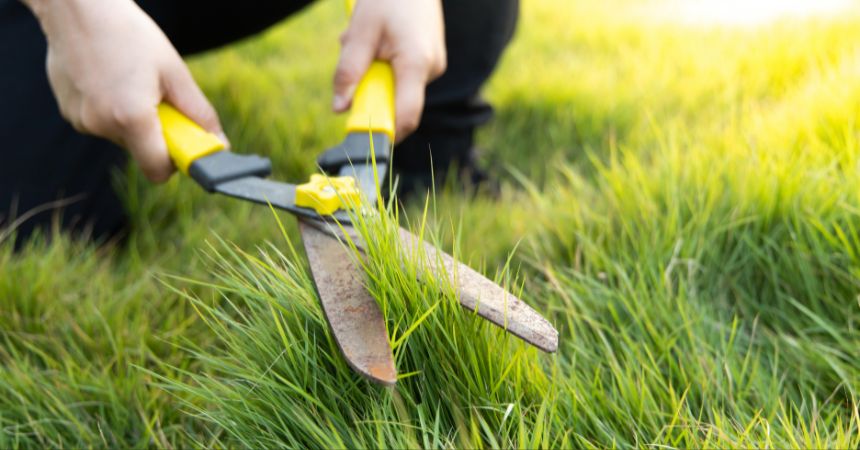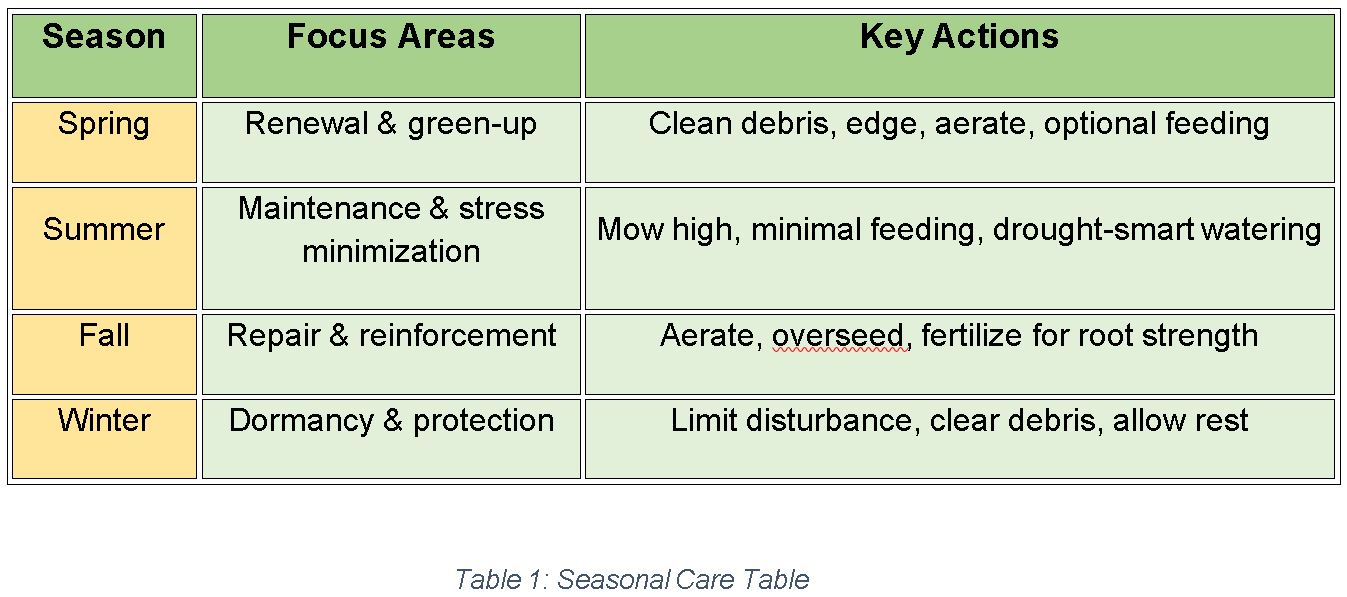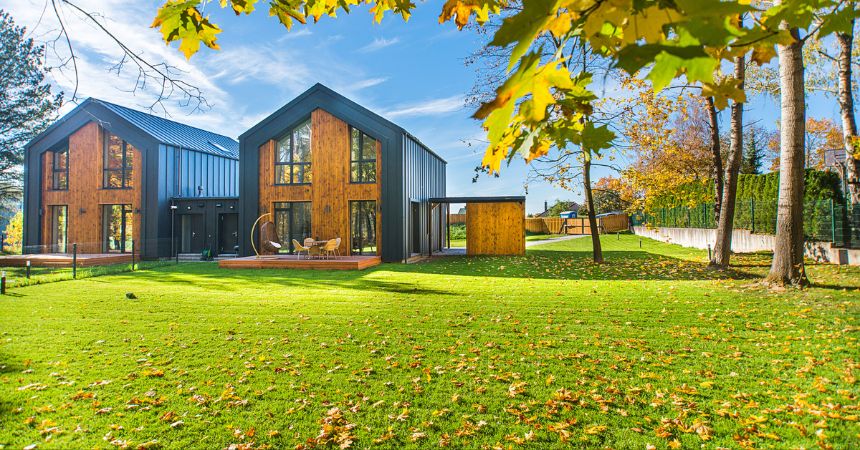How to Take Care of Your Lawn?
Maintaining a healthy lawn involves regular mowing, watering, soil-specific fertilization, and timely weed control. Aeration and thatch removal can also improve soil conditions and grass health.
Oregon State University claims that grass that fits in well with its surroundings is less likely to have moss, weeds, pests, and illnesses. This makes it a solid base for long-term health. The first stages to a strong, healthy lawn are planting it correctly and paying attention to the kind of grass, soil, and sunshine it gets.
The university also suggests mowing the lawn regularly, keeping the blades sharp, cutting no more than a third of the grass height at a time, and changing directions to minimize ruts and compaction.
When you mulch mow, you leave finely chopped clippings on the grass. This recycles important nutrients and may cut down on the need for fertilizer by a lot. This method, helps build a green, long-lasting lawn base.

What Are the Types of Lawn Grass and How to Care for Them?
There are two main types of lawn grasses: warm-season grasses, which include Bermudagrass, Zoysiagrass, St. Augustinegrass, etc., whereas cool-season grasses are Kentucky Bluegrass, Tall Fescue, and Fine Fescue, etc. Each type grows best in a certain climate and needs different levels of care.
Here’s a concise overview of each grass type commonly used:
Warm Season Grasses
- Bermudagrass: It spreads rapidly through stolons and rhizomes under full sun and high traffic. It needs full light and becomes brown and dormant in chilly winters. Mow low (0.5–2 inches), fertilize throughout summer growth, and water thoroughly.
- Zoysiagrass: Dense and soft, it handles heat well and resists weeds. It has a slower growth rate, requiring less mowing but more patience for establishment.
- Augustinegrass: It is a warm-season grass with coarse blades that tolerates shade. It grows well in warm, wet regions but is less drought- and traffic-resistant than Bermudagrass. Mow 2.5–4 inches, fertilize gently, and watch for chinch bugs in sensitive areas.
Cool Season Grasses
- Kentucky bluegrass: This fine-textured, luscious green plant spreads by rhizomes to self-repair. It grows in full sun with continuous hydration but struggles in summer heat and drought. Fertilization is most effective in the late spring and autumn, and the optimal height to mow is 2.5–3.5 inches.
- Tall Fescue: Deep-rooted tall fescue tolerates heat and drought better than other cool-season grasses. It tolerates foot activity and mild shade, but it clumps, so overseeding is needed to maintain density. Fertilize in autumn and spring, mow 3–4 inches, and water thoroughly.
- Fine Fescue: This delicate, narrow-bladed plant tolerates shade and has poor fertility. Cooler summers and well-drained soils are ideal, but high traffic is undesirable. Maintain 2.5–3.5 inches, fertilize gently, and keep irrigation low to avoid overwatering.
How to Take Care of Your Lawn through the Seasons?
Proper mowing, deep, infrequent watering, fertilizing, overseeding, and leaf management are best done in the autumn, while limited activity, cleaning waste, and preparing grass for spring are the responsibilities of the winter season, in order to maintain a flourishing lawn Penn State College of Agricultural Sciences. Here’s how to approach lawn care across the four seasons for optimal results.

How to Take Care of a New Lawn?
You need to keep it wet, not disturb it too much, and get rid of weeds early. According to The University of Maryland freshly seeded or sodded lawns require light watering every day to keep the top 1–2 inches of soil wet until the roots grow. Once the grass is 3–4 inches tall, gently mow it with sharp blades, taking off no more than a third of the height. Don’t walk on the grass too much and wait until it has grown (usually 4–6 weeks) before fertilizing.
How to Take Care of Your Lawn after Seeding?
Water carefully 2–3 times a day until the grass seedlings are 2–3 inches tall, prevent high foot traffic, and wait to mow until the new grass is strong enough to recover. Freshly planted lawns need to be watered every day, particularly when it’s dry or windy, to keep the topsoil constantly moist without being too wet The University of Maryland.
Here’s how to care for your lawn after seeding for the best growth and long-term health:
- Daily Light Watering: Use fine mist or short bursts multiple times a day for the first 1–2 weeks, especially in hot or windy weather, to prevent seed washout and encourage germination.
- Adjust Watering Schedule: As seedlings emerge, gradually reduce the frequency but increase the depth. Aim to wet the top 4–6 inches of soil so roots are encouraged downward.
- Careful Mowing: Only begin mowing when the grass reaches 3–4 inches tall. Mow at the highest setting and only remove up to one-third of the blade height each time. Waiting allows roots to strengthen and ensures better turf density, according to Southern Living.

How to Take Care of Your Lawn after Hydroseeding?
It’s important to water the lawn gently several times a day for the first 2–3 weeks to keep it consistently wet. Wait until the grass is approximately three inches tall before mowing, and stay away from the area to protect the young seedlings.
Hydroseeding helps seeds germinate quicker and covers the area more evenly, but it also needs careful attention at the start. During the first two weeks, you should water your hydroseeded lawn every day for 10–20 minutes to keep the top wet. This helps the seeds touch the soil and germinate.
How to Take Care of Your Lawn before Aeration?
Make sure the soil is sufficiently damp before you aerate so the tines may readily penetrate. To prepare the soil for watering without making it too muddy, The University of Maryland suggests watering the grass one to two days before, using around one inch of water.
To help the procedure work well, mow the grass a little shorter than normal. Also, label any underground wires, sprinkler heads, or shallow irrigation lines so they don’t get damaged. Get rid of sticks and leaves so that the aerator can get to where it has to go.
Aeration works better and protects the lawn’s substructure when you pre-moisten the grass, cut it a little shorter, and remove obstructions.
How to Take Care of Your Lawn after Cutting Grass
The best method to take care of your lawn is to water it moderately if the soil is dry, leave fine grass clippings on the ground to break down and provide nutrients, and keep the mower blades sharp to avoid damaging the grass. For longer-lasting green grass, these steps help it grow stronger roots and heal faster.
You may reduce your fertilizer needs by returning nitrogen to the soil by leaving grass clippings on the lawn, says the University of Minnesota. The Lawn Institute suggests watering your lawn first thing in the morning after mowing, if necessary, to prevent disease and water loss due to evaporation. Clean cuts heal more quickly with sharp blades, reducing the likelihood of fungal infections.
How to Take Care of Your Lawn after Dethatching?
To help your lawn recover after dethatching, water it thoroughly to restore moisture, then apply a balanced, slow-release fertilizer to replace lost nutrients. Overseed any bare or thin spots to promote fresh growth, and keep the soil evenly moist for several weeks to aid seed germination. Limit foot traffic until the grass has fully established.
Irrigate the grass 0.5–1 inch to alleviate stress and settle the soil, according to the University of Minnesota Extension. This also helps keep the roots hydrated when the grass is weak. Remove any dry places and promptly overseed with a temperature- and grass-suited seed type. For improved root growth, apply a starting fertilizer if a soil test indicates that phosphorus is necessary.
How to Take Care of Your Lawn after Scarifying?
Remove loose debris, then gently mow if required. Give your lawn a balanced fall or spring feed to help it recover. Even out the growth by overseeding any areas that aren’t covered. Water lightly frequently for the first several weeks to keep the soil wet, states The Royal Horticultural Society (RHS).
Scarifying gets rid of moss and thatch, which makes it easier for air and nutrients to get to the grass, but it also makes the grass more sensitive. Feeding restores nutrients, overseeding prevents weeds, and watering promotes root growth.
For healthy, consistent regrowth, it’s best to limit foot traffic as the grass recovers and to remove weeds and pests early on.

How to Take Care of Your Lawn with Pets?
Regularly picking up pet waste, training them to use specific areas, and fixing damaged areas quickly can keep your grass healthy when you have pets.
It is best to train them to avoid grassy areas and instead utilize mulched beds or designated border zones.
When damage occurs:
- Rinse affected spots promptly to dilute nitrogen and salts.
- Reseed damaged areas with a hardy grass type to accelerate recovery.
- Leave clippings, mow higher to reduce stress, and consider adjusting your pet’s diet (with vet guidance) to reduce nitrogen levels in urine.
Water immediately after pet accidents and repair spots through overseeding and smart maintenance.
How to Take Care of Your Lawn in Tulsa, Oklahoma?
The best lawn care approach is to choose grass types suited to the region’s climate, mow at the proper height, water deeply with proper frequency, and fertilize based on soil test results.
The Oklahoma State University suggests choosing grass types that work well in Tulsa’s environment. For example, Bermuda, Zoysia, and St. Augustine grasses are warm-season grasses that do well in hot summers, while tall fescue is a cool-season grass that does well in cooler regions.
Watering the lawn deeply but not too often helps the roots develop deeper, making the grass more resistant to dry times. Not watering too much also helps keep fungal diseases away. Soil test results should guide fertilizer to ensure grass receives the appropriate nutrients like nitrogen at the right time and reduce waste and environmental harm.
